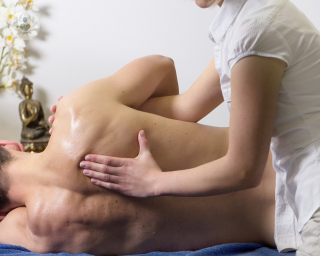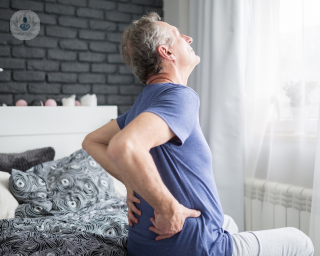Low back pain
Dr Elena Nikiphorou - Rheumatology
Created on: 10-19-2015
Updated on: 09-20-2023
Edited by: Kate Forristal
What is it?
Lumbalgia, commonly known as low back pain, mainly affects the lower area of your back.
It could be a symptom associated with several different conditions which can in turn arise from several different causes.
There are three main types of lower back pain, based on how long it lasts:
- acute: lasting less than one month;
- subacute: lasting between one and three months;
- chronic: lasting more than 12 weeks.

What are the symptoms?
The pain you experience depends on the nature and cause of the back pain, and can extend to:
- your thighs
- the inguinal area and the anterior part of your thigh
- the hips
- the glutes
Based on how severe it is, it can even prevent you from moving or doing everyday activities.
You should seek medical help immediately if you are having difficulties when urinating, or if you feel weakness or numbness in your legs.
How is it diagnosed?
Your GP will look at you and go through your medical history to diagnose what’s causing the back pain.
Following this, it is likely you may need to have further exams including:
- an X-ray of your back
- CT scan
- MRI scan
- blood test
- electromyography
- bone scintigraphy
- myelography
What causes it?
There are several causes for low back pain. The most common causes are small injuries, strains, contractures, sprains or sciatica.
The most common risk factors include smoking, being overweight or obese, a sedentary lifestyle, wearing high-heels shoes, excessively intense or bad form workouts, poor posture, sleeping on an unsuitable mattress, occlusal disorders and cold shock.
Furthermore, women can suffer from more or less severe back pain due to PMS or to the period itself, endometriosis, ovarian cysts, uterine fibroids or pregnancy (especially during the thirdt trimester).
Low back pain can also be a symptom of more severe conditions of your back, such as arthritis, a herniated disc, scoliosis, ankylosing spondylitis, appendicitis or kidney stones.
Finally, many people may have back pain with no clear cause, often referred to as “non-specific back pain”.
How can it be prevented?
You can try to prevent low back pain in the following ways:
- exercising regularly
- improving your posture
- practising relaxation techniques and stress management techniques
- losing the excess weight
- quitting smoking
- learning how to properly lift weights, which can avoid muscle sprains
- sleeping on a good quality mattress.
How is it treated?
Your GP may suggest a few treatments, such as:
- anti-inflammatory painkillers for short-term relief
- physical therapy
- massage therapy
- heat packs (to help loosen stiff muscles) or ice packs (to reduce swelling and inflammation) on the affected areas;
if your herniated disc is causing you a lot of pain, or if you have spinal stenosis, surgery to decompress and stabilise the pain may recommended.
Which doctor should I talk to?
Based on the nature and cause of low back pain, your GP may refer you to one of these medical professionals:

















